Discovering Unique Bird Pets: A Comprehensive Guide
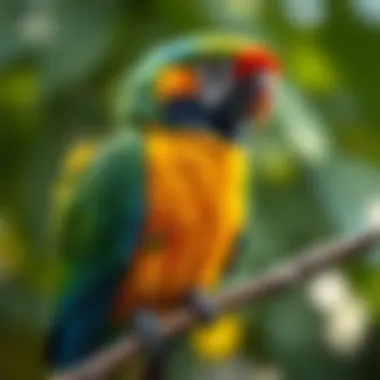
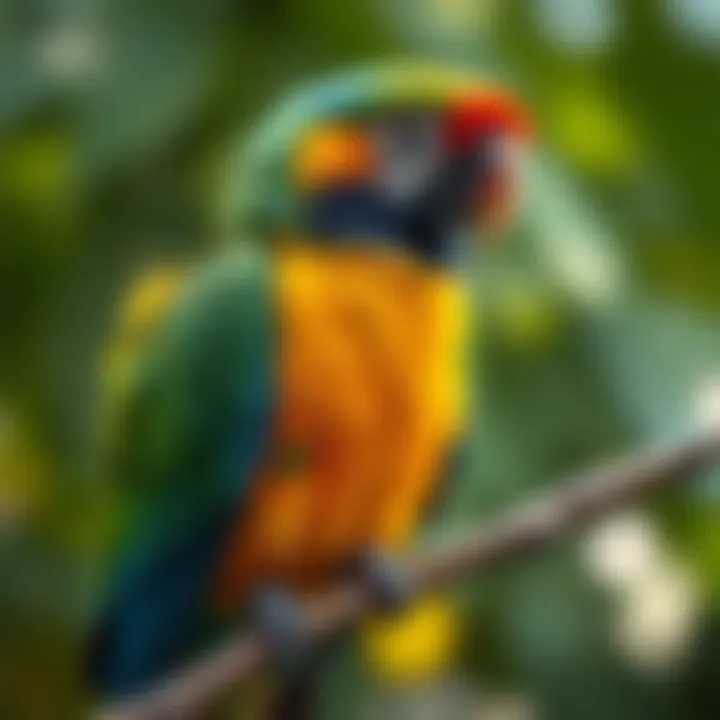
Intro
Birds have graced our planet for millions of years, each species showcasing unique colors, melodies, and personalities. More than just companions, avian pets can become an integral part of our lives. They’re spirited, affectionate, and possess an undeniable charm. With various breeds to choose from, finding the right bird pet can prove both exciting and daunting. This guide will offer you a well-rounded look into the captivating world of cool bird pets, taking into account their characteristics, care requirements, and the nuances of maintaining a rewarding relationship with your feathered friends.
Through understanding the needs of different bird species, you can better appreciate their quirks and requirements, ensuring both you and your pet enjoy a harmonious existence. Whether you’re a newcomer eager to welcome a bird into your home or a seasoned owner seeking to deepen your knowledge, this guide is crafted to provide valuable insights. Prepare to embark on a journey through the fascinating attributes of popular breeds, their behaviors, and actionable advice on their care and training.
In the following sections, we’ll dive into grooming techniques, health and wellness, training and behavior, product reviews, and community insights, all aimed at enhancing your relationship with these incredible avian companions.
Foreword to Bird Pets
Birds make for fascinating companions, bringing color, vibrancy, and a touch of the wild into our homes. With their rich array of species, each possessing unique characteristics, the world of avian pets offers something for everyone. This section serves as a window into why birds are cherished pets, drawing attention to the qualities that make them desirable companions, while also addressing the specific needs of these captivating creatures.
Defining the Appeal of Birds as Pets
Birds have been symbols of freedom and beauty throughout history. Their ability to fly resonates with our longing for exploration and adventure. Many find solace in the sweet chirps or melodic songs of these pets, which can brighten even the dullest of days. A parakeet's playful antics or a cockatiel's affectionate nature can bring warmth into a household, forging connections that often transcend mere companionship.
Unlike traditional pets like cats or dogs, birds can often integrate effortlessly into various living situations. With small species that adapt well to apartment life, their compact size can be ideal for urban dwellers. Their low-maintenance grooming requirements also make bird care relatively simple. However, enjoying a bird's company requires understanding their behaviors and needs, as they are social creatures that thrive on interaction and stimulation. This notion elevates bird ownership to an engaging partnership rather than servitude, where both owner and bird gain companionship.
Cultural Significance of Birds
Throughout various cultures, birds have held profound meanings, serving as omens in ancient mythologies, and even as messengers of peace. In many Indigenous cultures, birds symbolize the connection between the earthly realm and the heavens. They are celebrated for their roles in folklore, suggesting a wider appreciation for their presence in human life.
In contemporary society, birds are often seen in art, literature, and even in social media, where their beauty and behavior captivate countless followers. Platforms like Reddit or Facebook present opportunities for bird enthusiasts to engage, share, and learn together, fostering a community centered around their shared love for these creatures. Many unique cultures have traditions surrounding birds, ranging from parrot shows to canary singing contests, underlining how embedded these pets are in the social fabric of communities around the globe. Further, aspects of birdwatching have encouraged awareness about conservation efforts, indicating that the allure of birds stretches well beyond our homes, often into broader environmental contexts.
In summary, to embark upon bird ownership is to enter a world enriched with history, culture, and personal connection. Understanding the appeal of birds asks potential owners to reflect on both their desires for companionship and the responsibilities that come with it.
Popular Bird Species as Pets
In the ever-expanding universe of pet ownership, birds present a unique allure that has captivated countless hearts. The charm of avian pets goes beyond mere aesthetics; it lies in their vibrant personalities, diverse species, and the unique companionship they offer to humans. By understanding popular bird species, potential owners can better appreciate the specific needs and characteristics that make a feathered friend a delightful addition to their household. This section will delve into the attributes of various bird types, weighing their benefits and considerations, and guiding prospective bird enthusiasts in making an informed choice.
Parakeets: The Colorful Companions
Parakeets, often seen flitting about pet stores in a kaleidoscope of colors, are indeed a favorite among many bird lovers. These lively little creatures, also known as budgerigars or "budgies," vary from bright greens and yellows to soft blues and pure whites. What sets them apart is not just their bright plumage but their charming antics and sociable nature. Generally, they are quite easy to care for, making them an ideal starting point for novice bird owners.
- Social Creatures: Parakeets thrive on interaction. They can mimic sounds and even learn simple words, making them enjoyable companions. Their playful demeanor is often infectious, bringing joy to any space they inhabit.
- Easy Maintenance: Feeding them mainly consists of a mix of seeds, pellets, and fresh vegetables. With a clean cage and fresh water, they can live happily with minimal fuss.
- Lifespan: While they don’t require a lifetime commitment like some larger parrots, parakeets can live up to 10 years, making them a manageable choice for many.
In summary, if you’re looking for a vibrant bird that brings a splash of color and laughs to your life, parakeets could be the perfect fit.
Cockatiels: The Affectionate Singers
Cockatiels are often described as the musical heart of bird ownership. Renowned for their sweet disposition and charming whistles, they can provide both companionship and a pleasant auditory experience. The most endearing feature of these birds is their ability to bond strongly with their human caregivers.
- Affectionate Nature: Known for leaning into strokes and even nuzzling against their owners, cockatiels forge deep emotional bonds, often seen perched on their humans’ shoulders.
- Singing Talent: They are exceptional songsters, capable of picking up melodies. The sound of a cockatiel's whistle can be both soothing and enlivening, brightening up the day's gloom.
- Low-space Requirements: Cockatiels do not need massive cages; they thrive in smaller spaces as long as they can stretch their wings periodically.
When contemplating a companion, cockatiels deliver the dual benefits of companionship and harmonious entertainment, solidifying their status in the avian pet realm.
African Grey Parrots: Intelligence and Bonding
The African Grey parrot stands out in the avian community for its exceptional intelligence and social skills. These birds are often considered among the smartest of all pet birds, showcasing cognitive abilities and emotional depth that are genuinely astonishing.
- Impressive Vocabulary: Known for their ability to mimic human speech with remarkable accuracy, African Greys can develop extensive vocabularies, offering a sense of connection with their owners.
- Bonding Potential: They form strong emotional ties and can become incredibly attached to their human companions. Their interaction can be both rewarding and, at times, challenging due to their need for mental stimulation and social interaction.
- Lifespan Considerations: African Grey parrots can live over fifty years with proper care, suggesting a long-term commitment that potential owners must consider seriously.
In short, the African Grey offers a unique combination of intelligence and sociability, making them a valuable addition to families that can invest the time and effort in nurturing a deep bond.
Lovebirds: The Endearing Pairs
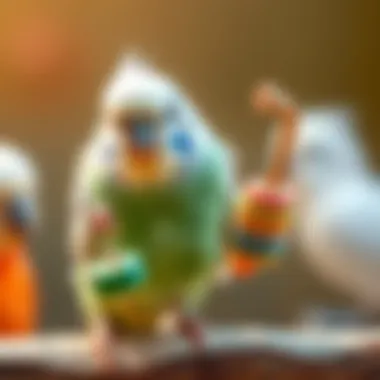

If you fancy an avian duo, look no further than lovebirds. These small parrots are often seen as symbols of affection due to their strong pair bonds, making them perfect for owners looking to cultivate a loving environment. Lovebirds come in a variety of colors, including peach, green, and yellow.
- Strong Bonds: Lovebirds are not just charming visually; their connection to one another is palpable, and they thrive best in pairs. Their interactions can be both playful and tender, providing amusement and heartwarming encounters.
- Sociable Creatures: While they often enjoy the company of their mate, they can also bond with humans if handled gently from a young age.
- Manageable Size: Their compact size allows them to fit comfortably into any living situation, from small apartments to larger homes.
For those desiring a heartwarming display of affection, lovebirds are an excellent choice, showcasing the profound connections that can flourish between species.
Canary and Finch: The Small Melodic Pets
Canaries and finches may be on the smaller side, but they certainly pack a punch when it comes to personality and song. These small birds are often appreciated for their serene presence and delightful melodies.
- Minimal Care Requirements: Both canaries and finches are relatively low-maintenance. They enjoy fresh seeds, occasional fruit, and a clean habitat, making them accessible for those new to bird ownership.
- Variety of Songs: Canaries are especially known for their singing capabilities, while finches offer a delightful chatter that can fill a home with delightful sounds.
- Visual Appeal: Available in a variety of colors and species, these birds can also serve as stunning visual accents in any room.
For those seeking a light-hearted, melodious presence in their lives, these small birds offer charm without the extensive time demands of larger companions.
In summary, popular bird species not only vary in appearance and behavior but also in the level of commitment they require. Understanding these distinctions enables potential owners to choose a bird that aligns not only with their lifestyle but also with their emotional needs. Knowing the right species can lead to lasting joy and companionship.
Choosing the Right Bird for You
Selecting the right bird may seem like a walk in the park, but it’s a decision that requires careful thought. Birds are not just pets; they are companions that rely on their owners to fulfill their needs—emotionally, physically, and socially. When deciding which feathered friend is right for you, it’s crucial to consider various elements such as your lifestyle, living space, and the time you can devote to them. Understanding these factors ensures that both you and your avian companion lead fulfilling lives together.
Assessing Personal Lifestyle
Before rushing into adopting a bird, take a moment to look inward. Think about your daily routine. Do you travel often? How many hours a day are you home? Birds are social creatures that thrive on interaction with their owners. For example, a busy professional might consider a species that requires less attention, like a finch, while someone who works from home might choose a more social bird, like a cockatiel. Here’s a list of questions you might ask yourself:
- How much time can I dedicate daily to my bird?
- Will I be home to interact with my bird frequently?
- Do I have children or other pets that might coexist with a bird?
By answering these questions, you can better align your choice of pet with your lifestyle. If you’re out of the house for long hours, a bird that is more independent may be best for you.
Understanding Space Requirements
Birds come in different sizes, and so do their housing needs. A small parakeet can be housed in a smaller cage, while a larger species like an African Grey needs ample space to fly and move around comfortably. You should consider not only the size of the cage but also the area around it—birds need room to stretch their wings and engage in exercise. Things to keep in mind when it comes to space include:
- The minimum cage size suitable for the species.
- The safety of the space (windows, plants, and any potential hazards).
- Any additional accessories or toys that will occupy the space.
A cramped environment can lead to stress for a bird, so ensuring they have adequate room to roam is essential for their well-being.
Time Commitment and Social Interaction
Keeping a bird is a long-term commitment that shouldn’t be taken lightly. These animals, depending on the species, can live for many years—some even outlasting human companions. Therefore, you need to ask yourself:
- How often will I be able to play with and train my bird?
- Am I prepared for the potential long-term emotional investment?
- Can I provide consistent companionship to my bird?
Birds can become quite attached to their owners, and neglecting their social needs can lead to behavioral issues such as screaming or feather plucking. Taking time to bond with your bird is just as important as providing food and shelter. It’s beneficial to build routines that include playtime, training, and interaction to promote a harmonious relationship.
"A happy bird is a healthy bird."
Caring for your bird goes beyond just meeting basic needs; it involves creating an enriching and loving environment where they can thrive.
Choosing the right bird for your circumstances will lay the groundwork for a rewarding and enjoyable partnership. Reflect on your personal situation, living conditions, and willingness to invest time, and you’ll find the feathery companion that suits you best.
Basic Care and Maintenance of Bird Pets
The significance of basic care and maintenance for bird pets cannot be overstated. A well-maintained environment and proper care not only enhance the quality of life for your feathered companions but also foster deeper bonds between you and your avian friends. Many times, new pet owners might overlook specific needs which can lead to a myriad of behavioral issues and health problems down the line. Understanding the essentials can pave the way for a happy and thriving bird companion.
Optimal Diet for Avian Health
Feeding a bird is not as simple as throwing seeds into a dish and calling it a day. Birds require a balanced diet made up of high-quality pellets, fresh fruits, and vegetables. For instance, cockatiels thrive on a blend of seeds, but you cannot ignore the crucial role that greens play in their diet. A nutritious diet can bolster their immune system, keeping them active and playful.
Key food items include:
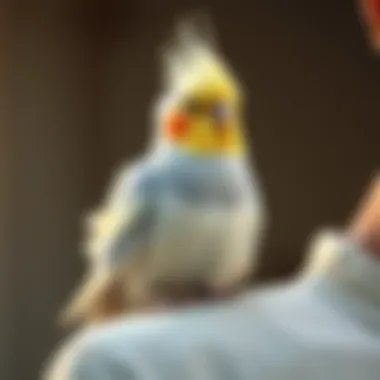
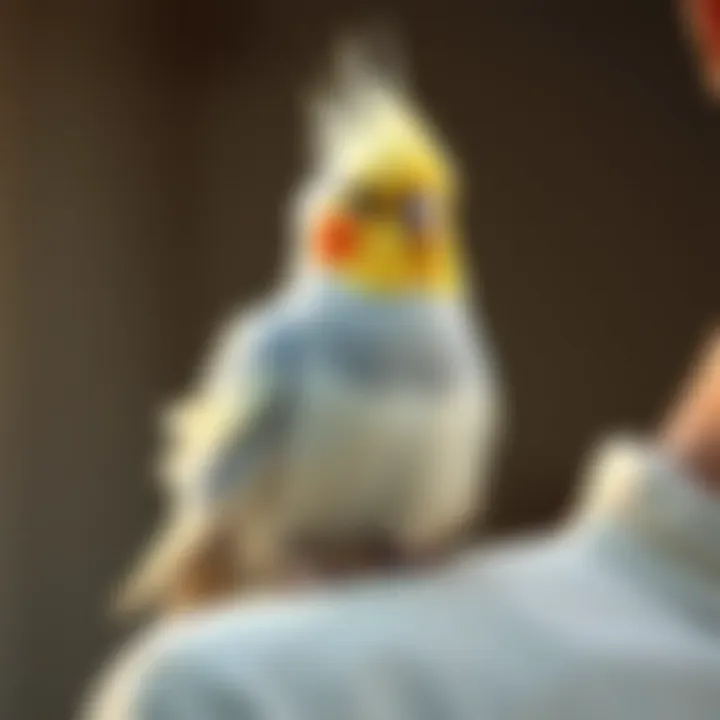
- Leafy greens like kale and spinach, which provide essential vitamins.
- Fruits such as apples and bananas that offer natural sweetness and hydration.
- Pellets specifically formulated for your species, ensuring necessary nutrients.
Avoid feeding birds avocados and chocolate, as these items are toxic. To ensure a varied diet, change up their food regularly and observe what they enjoy. A bird's diet should be as colorful as its plumage, leading to a happy, vibrant pet.
Cage Setup and Environment
Creating the right environment for a bird is pivotal. It’s safe to say that the cage acts as a bird’s home, a sanctuary where it feels secure. A good cage should be spacious enough to allow for flapping, climbing, and other natural behaviors. Thoughtful installation of perches, toys, and nesting areas promotes a stimulating environment.
When arranging their space, consider the following elements:
- Cage size: At a minimum, cages should be the wider than the wingspan of the bird.
- Perches: Utilize branches of varying thickness to encourage foot health.
- Toys: Rotate toys frequently to keep your bird engaged and curb potential boredom.
Furthermore, the placement of the cage matters. Birds can be social creatures, so positioning the cage in a busier area of your home can help them feel included in family activities. However, avoid places that are too loud or have direct sunlight for long periods, as this can stress them out.
Regular Health Check-Ups
Much like how humans need routine check-ups, birds require regular visits to an avian vet. These assessments can catch potential health issues before they escalate into something serious. Birds often hide their ailments until they become quite severe, so proactive healthcare is key.
During these check-ups, expect a thorough examination that may include:
- Feather condition: Checking for molting or signs of feather plucking.
- Weight check: Monitoring weight helps track overall health, as sudden fluctuations can indicate a problem.
- Beak and nail trimming: Regular maintenance prevents issues related to overgrowth.
It's also wise to get your birds vaccinated appropriately and to keep an eye on their behavior at home. Sudden changes in their habits can be an early warning sign that something's off, warranting a visit to the vet.
"Adopting a bird isn't just about having a pet; it’s about inviting a lively companion into your life, requiring commitment and care."
By adhering to these essential aspects of feeding, housing, and healthcare, you'll be well on your way to providing your bird companions with the enriching life they deserve. For further information on proper avian nutrition, check Wikipedia's page on macro-nutrients for birds. Ensure that your feathered friends live a fulfilling life packed with joy and health.
Behavioral Understanding in Bird Care
Understanding bird behavior is essential for anyone who desires to keep a feathered friend. Not only does it enhance the bond between you and your pet, but it also plays a significant role in their overall well-being. Birds, much like humans, have complex personalities and sometimes quirks that can make living together challenging if not understood. A grasp of their behavior aids in addressing issues, promoting enrichment, and ensuring that the avian companion flourishes in a home setting.
Recognizing Bird Body Language
Birds communicate through body language more than vocal sounds. If you take a moment to observe, you'll see that small changes in posture or movement can reveal a lot about their feelings. For instance, if your parakeet is puffing up its feathers, it might be feeling chilly or trying to assert itself. On the other hand, a bird that is wagging its tail or moving around enthusiastically might be feeling playful and energetic.
Common indicators include biting and flapping: a bird that bites may be feeling threatened or stressed, while a bird that flaps its wings without flying could be seeking attention or stimulation. Recognizing these signals is like finding a key to a door; it unlocks understanding and allows for better interaction.
Addressing Common Behavioral Issues
Every bird pet can exhibit behavioral problems at some point. If your cockatiel starts screaming at odd hours or plucking its feathers, it’s sending up a red flag. These issues can stem from improper care, stress, or even boredom. It's crucial to approach these behaviors calmly. You might want to consider assessment of their environment first. Is the cage big enough? Do they have adequate toys? These factors play an important role in mitigating issues.
Also, remember that each bird species has its character traits. What may be normal for a lovebird might seem odd for a canary. Getting to know the expected behaviors of your specific type can give you a clearer picture of what needs to be addressed. As the saying goes, "an ounce of prevention is worth a pound of cure." Identifying and acting on behavioral signs early is key to maintaining harmony in the household.
Importance of Socialization and Stimulation
Birds are social creatures, and they thrive on interaction and stimulation. Socialization helps reduce stress, promotes happiness, and prevents unwanted behaviors. Imagine leaving a child alone in a room with no toys for hours; they would likely become bored and cranky. Similarly, your bird craves interaction — whether it’s playing with you, exploring new toys, or simply moving around in a safe environment.
Consider introducing playtime sessions into their daily routine. Simple attention can work wonders; spend time talking softly, allowing them to explore new sounds, or give them varied experiences to keep their minds sharp. You can also include perches, swings, and challenging toys that require some thought. Not only does this prevent boredom, but it also encourages mental health and development.
"A happy bird is a healthy bird; their well-being is often reflected in their behavior."
As you nurture this bond and improve understanding, both you and your feathered companion can enjoy each other's company to the fullest. In essence, recognizing behaviors, addressing issues, and ensuring social interaction are cornerstones of effective bird care.
Training and Enrichment for Your Bird
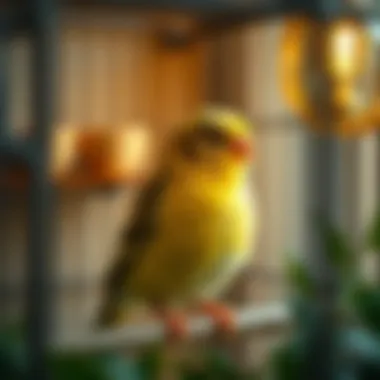
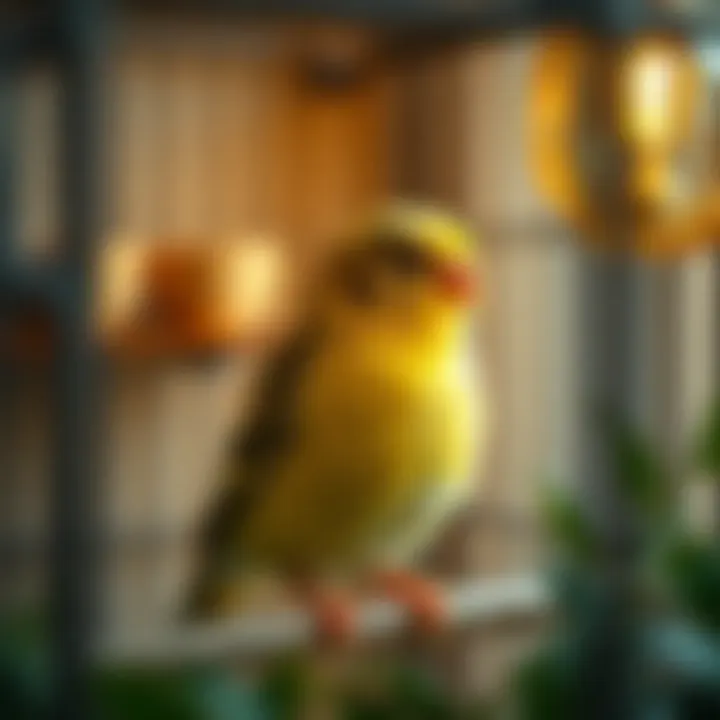
Training and enrichment play a vital role in the health and happiness of your avian companion. While many may think of birds simply as pets to gaze at or listen to, they require—just like dogs or cats—a significant investment of time and effort to thrive. Engaging in training not only helps establish a bond between the bird and its owner but also keeps the bird mentally stimulated and physically active. Without this kind of mental and physical engagement, birds may turn to destructive behaviors borne out of boredom or frustration.
Basics of Bird Training Techniques
Training a bird takes patience and understanding. Different techniques can be employed, but the foundation is rooted in positive reinforcement, a method where desired behaviors are rewarded to encourage repetition. Here are some effective strategies to consider:
- Target Training: This technique uses a stick or any small object, which the bird is taught to touch. Move the target and reward your bird when it follows it. This method can lead to advanced tricks, enhancing the bird’s activity levels.
- Clicker Training: A clicker makes a distinct sound that, when paired with treats, signals to the bird it's done something right. This clear communication fosters a quicker learning pace.
- Repetition: Like teaching a toddler, repeating commands or tricks consistently is key. Make sure to use the same phrases. If you frequently change how you address commands, the bird will become confused.
- Short Sessions: Birds have limited attention spans. Short, five to ten-minute sessions several times a day tend to fare better than long, exhaustive training.
Utilizing these training techniques yields a mutually beneficial relationship, where the bird learns and the owner enjoys showcasing pet’s new skills.
Interactive Toys and Mental Challenges
A bird's natural instinct is to forage and explore, so providing interactive toys is essential. Not just any toy will suffice; it should offer challenges that cater to their intelligence. Here are several forms to consider when choosing the right toys:
- Puzzle Toys: These toys require effort to unearth treats, encouraging problem-solving skills. They come in various designs that can confuse and engage birds at different levels.
- Foraging Toys: Mimicking the search for food in the wild, these stimulate a bird’s natural foraging instincts. Stuff them with seeds or favorite snacks to keep your feathered friend occupied for hours.
- Swing and Climbing Structures: Birds love to climb and swing—they’re natural acrobats after all! Providing horizontal and vertical play structures challenges their physical abilities while letting them express their natural behaviors.
- Changing Toys Regularly: Rotate toys every month or so to keep things fresh. A new toy can rekindle excitement in your bird and stir its curiosity, making playtime more appealing.
"Enrichment is not just a luxury for avian pets; it’s a necessity that nurtures both their minds and spirits."
The investments made in training and mental challenges can manifest in an overall happier bird, less likely to engage in mischievous or harmful behaviors. Beyond mere companionship, owning a bird becomes a fulfilling experience through these interactions, ensuring that the bond between you and your feathered friend flourishes.
Considerations Before Adopting a Bird
Adopting a bird is not merely about bringing home a colorful companion; it's a significant commitment that often lasts many years. Before taking the plunge, potential bird owners should weigh several important factors that can profoundly affect both their lives and that of their avian friend.
Birds, unlike some other pets, can live for decades. From parakeets to African greys, the lifespan of these feathered creatures can range widely. This long-term commitment should not be taken lightly. An average budgerigar may live for 5 to 10 years, but larger parrots can live up to 50 years or more. An eight-year commitment can quickly spiral into a lifelong companion, which is why it's critical to assess how this factor aligns with your lifestyle and future plans.
"Birds bring joy, but they also need a stable home. Think hard before making that decision."
Long-term Commitment and Lifespan
Understanding the lifespan of various bird species is vital. The commitment you enter into is not just about feeding them and cleaning their cages; it's about forming a genuine bond over the years. For instance, if you are considering a cockatoo or an Amazon parrot, you are looking at a lifetime commitment of up to 80 years.
It's essential to assess your readiness for this sort of commitment. Are you stable in your job? Do you foresee any major life changes, such as moving cities or starting a family? These changes can significantly impact your ability to provide the environment your bird needs. Make sure you're truly prepared for the long haul. Having an exit strategy in place, if necessary, is also a prudent move.
Legal and Ethical Responsibilities
Bringing a bird home also comes with a unique set of legal and ethical responsibilities. Many countries have laws regarding the ownership of exotic birds. Some species might require permits, while others may be illegal to own altogether. Before bringing a bird into your home, ensure that you understand the laws in your area to avoid any troubles down the line. Websites like BirdLife International offer extensive resources that can help you navigate these legal waters.
Additionally, consider the ethical aspects. Are you adopting from a reputable breeder or rescue organization? Many birds end up in shelters due to abandonment or unsuitable living conditions. By adopting from a responsible source, you not only gain a companion but also help address the issue of birds in need of homes. Making an informed decision can contribute to the well-being of these creatures, and enabling them to live happy lives.
As you weigh these considerations, keep in mind that adopting a bird is as much about the bond you wish to build as it is about the responsibilities you’re willing to shoulder. Ensuring you’re not just looking for a pet, but ready to embrace a lifelong relationship with a remarkable creature, could make all the difference in the quality of life for both you and your new avian friend.
Closure: Embracing the Avian Experience
In wrapping up our exploration of bird companionship, it becomes clear that welcoming a feathered friend into one’s home comes with a treasure trove of benefits and responsibilities. Birds, from parakeets to African Grey parrots, offer their owners an abundance of joy, intelligence, and companionship. Choosing to care for these lively creatures isn't merely about having a pet; it's about cultivating a relationship that can significantly enhance one's quality of life.
Benefits of Bird Ownership
Owning a bird can bring an array of advantages, proving to be not just a hobby but rather a significant lifestyle choice. Some noteworthy benefits include:
- Emotional Support: The companionship of a bird can offset feelings of loneliness. Their presence provides comfort, creating a symbiotic relationship that often boosts one’s emotional wellbeing.
- Laughter and Joy: Birds are naturally playful and curious. Their antics may just brighten your day, whether it's a cockatiel singing a tune or a parakeet chatting away. Observing their behaviors can elicit genuine laughter, turning mundane moments into joyful ones.
- Educational Experience: For families especially, having a bird offers a great way to educate children about responsibility and empathy. Caring for a living creature teaches valuable lessons that extend beyond mere ownership.
- Space Efficiency: Unlike large pets, many bird species are suited for smaller living environments, making them ideal for apartment dwellers. Their cages take up minimal space while still providing ample environment for them to thrive.
"A bird in the hand is worth two in the bush." This age-old saying resonates perfectly with bird ownership. When you nurture a bird, you discover its quirks and complexes, adding depth to your own life.
Fostering a Connection with Nature
Birds symbolize a connection to nature that many yearn for, especially in our increasingly urbanized world. Keeping a bird close serves as a gentle reminder of the natural realm. Here’s how bird ownership fosters that crucial bond:
- Daily Alignment with Nature: Having a bird manages to bridge daily routines with the rhythm of nature. The sounds of chirping in the morning can align your mindset with the world outside, making even the busiest days feel a tad more natural.
- Encouraging Conservation Awareness: Owning a bird often awakens a sense of responsibility. As owners start to learn about their birds’ native habitats and behaviors, a spark of interest in conservation may blossom. This can motivate individuals to support local wildlife or participate in conservation efforts.
- Mindfulness and Presence: Spending time with a bird can promote mindfulness. As you engage with your pet, be it through play or simple observation, you become more present in the moment, allowing daily stressors to fade into the background.
Embracing the avian experience isn’t merely about enjoying a pet; it’s about forging a connection that echoes both joy and responsibility. The insights and challenges that come with caring for a bird enrich lives in meaningful ways. As we consider these aspects, the choice to welcome a bird into your home transforms into not just a decision, but a profound journey into the beauty of companionship and the great outdoors.
For more information about the perks of bird ownership and insights into avian care, check out National Geographic and the American Society for the Prevention of Cruelty to Animals (ASPCA) for deeper dives into parakeets, lovebirds, and their magnificent world.







